#Order: Semaeostomeae
Explore tagged Tumblr posts
Text



Range: Atlantic, Arctic, Pacific, & Indian Oceans
179 notes
·
View notes
Note
Placental jellyfish
Is it a placenta? Is it a jellyfish? NO! YES!
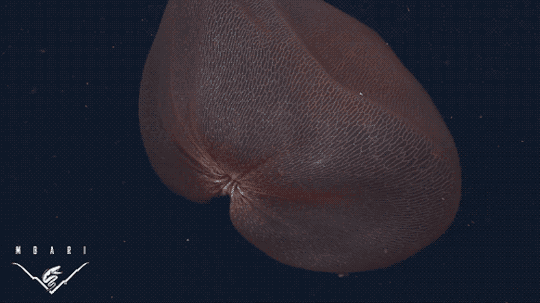
Deepstaria enigmatica, family Ulmaridae, order Semaeostomeae, class Scyphozoa
Usually found in Antarctic and near-Antarctic seas, but have been found in the Atlantic as far South as the Gulf of Mexico.
Usually found at depths of 600–1,750 m (1,970–5,740 ft).
This species is known to have symbiotic (possibly parasitic) isopods living in their bells.
Find out more:
Solving the Mystery of the Placental Jellyfish | Deep Sea News
Deepstaria enigmatica - Wikipedia
Better and New Video of the Enigmatic Placental Jellyfish | Deep Sea News
276 notes
·
View notes
Text
Round 2.5 - Cnidaria - Scyphozoa




(Sources - 1, 2, 3, 4)
Scyphozoa is a marine class of cnidarians commonly referred to as “true jellyfish”, “jellyfish”, or simply “jellies”. They are composed of three living orders: Coronatae (“Crown Jellies”), Rhizostomeae (“Root-mouth Jellies”), Semaeostomeae (“Flag-mouth Jellies”).
Scyphozoans usually display a four-part symmetry and have an internal gelatinous material called mesoglea, consisting of as much as 98% water. A ring of muscle fibres within the mesoglea surrounds the rim of the dome, and the jellyfish swims by alternately contracting and relaxing these muscles. As medusae, they eat a variety of crustaceans and fish, which they capture using stinging cells called nematocysts. The nematocysts are located throughout the tentacles that radiate downward from the edge of the umbrella dome, and also cover the four or eight oral arms that hang down from the central mouth. Some species, however, are instead filter feeders, using their tentacles to strain plankton from the water. The mouth opens into a central stomach, from which four interconnected diverticula radiate outwards. Some genera also have smaller mouths in the oral arms. The lining of the digestive system includes further stinging nematocysts, along with cells that secrete digestive enzymes. The nervous system usually consists of a distributed net of cells, although some species possess more organised nerve rings. Some species also have pigment-cup ocelli, though they are not as advanced as Cubozoan eyes. Coronataens (ex: image 2) are characterized by a deep groove running around the umbrella, giving them the crown shape which gives them their name. Rhizostomeans (ex: image 1 and 3) do not have tentacles nor other structures branching off from the edges of the bell. Instead, they have eight highly branched oral arms which fuse together as they approach the central mouth of the jellyfish. Semaeostomeaens (ex: image 4 and gif below) have four long, frilly oral arms flanking their quadrate mouths, as well as tentacles.
Most species of Scyphozoa have two life-history phases, including the planktonic medusa or polyp form, and the inconspicuous, but longer-lived, bottom-dwelling polyp, which seasonally gives rise to new medusae. Most species appear to be gonochorists, with separate male and female individuals. The gonads are located in the stomach lining, and the mature gametes are expelled through the mouth. After fertilization, some species brood their young in pouches on the oral arms, but they are more commonly planktonic. The fertilized egg produces a planular larva which, in most species, quickly attaches itself to the sea bottom. The larva develops into the hydroid stage of the lifecycle, a tiny sessile polyp called a scyphistoma. The scyphistoma reproduces asexually, producing similar polyps by budding, and then either transforming into a medusa, or budding several medusae off from its upper surface via a process called strobilation. The medusae are initially microscopic and may take years to reach sexual maturity.
Scyphozoans have existed since the Early Cambrian.
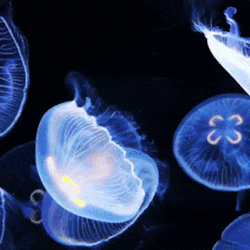
Propaganda under the cut:
The Lion’s Mane Jelly (Cyanea capillata) is one of the largest jellyfish, with the largest recorded specimen having a bell width of 210 cm (7 ft) and tentacles around 36.6 m (120 ft) long.
Jellyfish of the order Rhizostomeae are considered edible, both as a delicacy and for use in traditional medicine, and are eaten mainly in Asia, typically dried and/or salted.
The giant Nomura's Jellyfish (Nemopilema nomurai) can reach similar sizes to the Lion’s Mane Jellyfish, and their large size and quantity often negatively affects fisheries in East Asia. Aside from humans, their only predators are swordfish, tuna, sunfish, and leatherback sea turtles. A decrease in predators and an increase in favorable conditions and warming seas have caused an explosion in population, displaying that an increase in animal populations is not always a good sign! Scientists are studying their venom for use in medical applications, such as for treating joint disease and in cancer research. The Japanese company Tango Jersey Dairy also produces a vanilla and jellyfish ice cream using Nomura's Jellyfish.
While most jellies are exclusively marine, the Bay Nettle (Chrysaora chesapeakei) ventures into the Chesapeake Bay’s brackish water all the way up into the freshwater of Baltimore’s Inner Harbor.
The Giant Phantom Jelly (Stygiomedusa gigantea) is a deep sea jellyfish that is rarely seen, with only around 110 sightings in 110 years. It thought to be one of the largest invertebrate predators of the ocean's midnight zone and twilight zone, with an umbrella-shaped bell that can grow up to 1 m (3.3 ft) in diameter and paddle-like arms that can grow up to 10 m (33 ft) in length. The bell's pliant tissue allows for the jellyfish to stretch 4 to 5 times its size, presumably to engulf their prey. They do not have any stinging tentacles and instead use their arms to trap and engulf their prey which consists of plankton and small fish. The Giant Phantom Jelly has a symbiotic relationship with the Pelagic Brotula (Thalassobathia pelagica), for which it provides food and shelter beneath its massive billowing bell, while the fish aids the jelly by removing parasites.
The Mauve Stinger (Pelagia noctiluca) is a fairly small purple jellyfish that is able to glow in the dark (bioluminesce). Light is emitted in the form of flashes when the medusa is stimulated by turbulence created by waves or by a ship's motion. Unusually among cnidarians, Mauve Stingers are able to consume phytoplankton, alongside copepods and other usual planktonic fare.
The Moon Jelly (Aurelia aurita) (see gif above) is gaining popularity in aquarium touchtanks as they lack long tentacles and their sting has little to no affect on humans. They are also one of the longer-lived jellyfish, living up to two years in their medusa form, and are easy to rear and feed, making them a good candidate for giving humans an up-close learning experience with jellies.
Fun fact: my dad let me watch The Sphere (1998) when I was 7 and it gave me Scyphophobia, a fear of jellyfish, that lasted for several years. I knew the behavior of the jellyfish as depicted in the movie wasn’t real, but I still wouldn’t enter the ocean for the next 5 years, and when I did start entering the ocean again every time I saw a jellyfish I would get out and not go back in again for another full year. It took a touch tank and several positive experiences with some moon jellies to get over my fear, and now I would say I’m fully recovered!
100 notes
·
View notes
Text
I loooove jellyfish so much, especially my favorite: the Phantom Jellyfish ( sygiomedusa gigantea )
Kingdom: Animalia Order: Semaeostomeae
Phylum: Cnidaria Family: Ulmaridae
Class: Scyphozoa
fun facts because I wanna info dump :3
The diameter of the bell can grow up to be 1 meter and their arms¹ can grow up to a length of 10 meters.
They have no stinging tentacles!
The s. gigantea is the only species of deep sea jellyfish that is monotypic².
Only around 110 sightings of them have been seen for the past 110 years despite being believed to live widespread around the world.
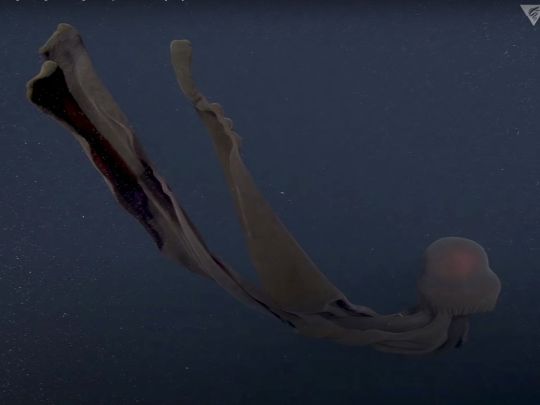
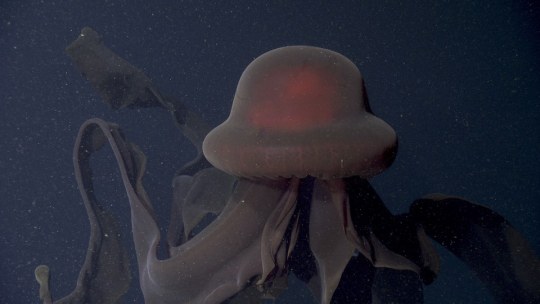
¹ Instead of stinging tentacles like usual jellyfish, the s. gigantea have arms to capture and trap prey. ( Plankton, small fish. )
² Monotypic in this context means that the species ( in this case, s. gigantea ) does not have any subspecies.
Let me know if I got anything wrong! Or add on anything if you'd like. If you hyperfixate on jellyfish, please tell me about your favorites!
ヾ(≧▽≦*)o
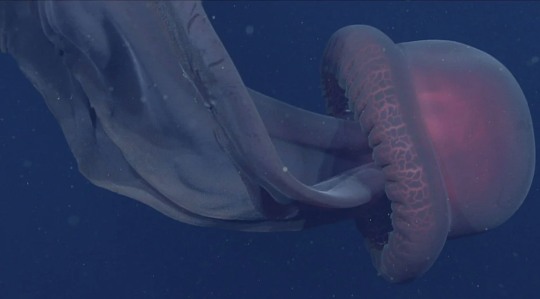
#jellyfish#phantom jellyfish#sygiomedusa gigantea#jellyfish facts#hyperfixation#info dump#biology#zoology
159 notes
·
View notes
Text
Ended up doing a taxonomy thing but I'm not sure if I'll ever properly use it for a post... anyways here's Class scyphozoa for you:

* Subject to change depending on individual species
Order Coronatae: ("Crown")
Tentacles, Lappets, Rhopalia, Mouth, Coronal Groove, Bell
Tentacles typically help up like a spiders'
Usually has 8 ball-like gonads under the bell
Suborder Discomedusae:
Order Semaeostomeae: ("Flag Mouth")
Bell, Oral Arms, Rhopalia, Tentacles
Frilly/ribbon-like oral arms
Order Rhizostomeae: ("Root Mouth")
Bell, Oral Arms, Rhopalia, Filaments
Broccoli-like oral arms
Filaments + Zooxanthallae optional
#.professor jellyfish speaks#jellyfish#art#scyphozoa#i tried to choose jellyfish that best represented each group#periphylla periphylla#chrysaora sp.#mastigias papua#hopefully everyjelly here can differentiate between the main three groups of Scyphozoa now ^-^!!
16 notes
·
View notes
Text
There are approx. 200 species of scyphozoa (true jellyfish)! They’re separated into 4 orders, those being: stauromedusae, coronatae, semaeostomeae, and rhizostomeae.
Hydrozoans are similar, but different. They are closely related and share a lit of similarities.
To help with this: Portuguese man o’wars and by-the-wind-sailors aren’t true jellyfish. Helmet jellies, cannonball jellies, and cauliflower jellies are true jellyfish
#biology#marine animals#marine biology#science#sea life#sealife#jellyfish#sea animals#underwater#fish#sea#sea jellies#seajellies#ocean#cnidarians#hydrozoan#siphonophore#scyphozoa
677 notes
·
View notes
Text

Speaking of the Vietnamese wiki pages- LOOK AT THIS!! LOOK AT THIS???
It’s a clusterfunk of a page.
It’s titled “Con sua” (the general word for jellyfish), but the page seems to talk specifically about Scyphozoa? But the orders (That’s what I think “Cac bo” is referring to) are... intelligible.
There are 3 extant orders in Scyphozoa as of late, that being orders Coronatae, Semaeostomeae, and Rhizostomeae. Order Rhizostomeae, despite being widely eaten and somewhat popular around East and Southeastern Asia, is absent from here. Two mysterious orders I haven’t even heard about are here as well, for some reason???
Anyways, searching them up on the English google didn’t get me anything exactly, but these seem to coincide with extinct fossil groups that have been speculated to be in class Scyphozoa at some point... (the wiki itself tells me this as well with some bits that I put through a translator lol)
#mun rambles#jellyfish#this is why i often say to look through wikis of different languages#there is so much neat information you can learn hahaaa#also fun fact in don't starve: wickerbottom refers to the jellyfish as Medusozoans#which is funny because Medusozoa encompases Classes Hydrozoa Scyphozoa and Cubozoa#and staurozoa i think#most experts could probably tell a rhizostomid jelly from a scyphozoan jelly i think#idk it's just interesting that she decided to go broad instead of specific#i suppose there really isn't any real-world equivalent for a rainbow rhizostomid jellyfish#though apparently the lizard-tail jelly is a bit rainbow like... hmm#haha#i will stop talking now
6 notes
·
View notes
Video
youtube
Weird and Wonderful: Otherworldly giant, red jellyfish swims into our minds
Like a big red spaceship cruising the ocean depths, Tiburonia granrojo truly is otherworldly. Despite its large size, scientists didn't encounter it until 1993. These giant jellies are found between 600–2,100 meters (2,000–7,000 feet) and the bell can reach up to one meter (3.3 feet) across. The fact that scientists could miss something so big and with such a wide range suggests that many more surprises await us in our exploration of the deep sea. MBARI researcher George Matsumoto discovered and described this giant red medusa with several colleagues. It was named 𝘛𝘪𝘣𝘶𝘳𝘰𝘯𝘪𝘢 𝘨𝘳𝘢𝘯𝘳𝘰𝘫𝘰 in recognition of the research contributions of the ROV Tiburon, retired by MBARI in 2008. The species name— granrojo means big red, a descriptive name that biologists used to refer to this jelly until it was formally named.
via: Monterey Bay Aquarium Research Institute (MBARI)
reference:
Matsumoto, G.I., K.A. Raskoff, and D.J. Lindsay (2003). Tiburonia granrojo n. sp., a mesopelagic scyphomedusa from the Pacific Ocean representing the type of a new subfamily (class Scyphozoa: order Semaeostomeae: family Ulmaridae: subfamily Tiburoniinae subfam. nov.). Marine Biology, 143: 73-77.
https://link.springer.com/article/10.1007%2Fs00227-003-1047-2
28 notes
·
View notes
Text
Moon jellyfish

Taxonomy
Domain - Eukarya
Kingdom - Animalia
Phylum - Cnidaria
Class - Scyphozoa
Order - Semaeostomeae
Family - Ulmaridae
Genus - Aurelia
Species - Aurelia aurita
Scientific Name
Medusozoa
Diet
The moon jelly is carnivorous and feeds on zooplankton. Their primary foods include small plankton organisms such as mollusks, crustaceans, tunicate larvae, copepods, rotifers, nematodes, young polychaetes, protozoans, diatoms and eggs.
Habitat
Moon jellyfish are native to coastal waters around the world, mostly the Atlantic, Pacific and Indian oceans. They are most common on the coasts of North America and Europe, where the water stays near their favorite temperatures for much of the year.
Reproduction
In the adult stage of a jellyfish, they can reproduce sexually by releasing sperm and eggs into the water, forming a planula. In this larval stage of jellyfish life, the planula hooks on to the bottom of a smooth rock or other structure and grows into another stage of jellyfish life During this stage, which can last for several months or years, asexual reproduction occurs. The polyps clone themselves and bud, or strobilate, into another stage of jellyfish life, called ephyra. It is this form that grows into the adult medusa jellyfish.
Growth and development
Jellyfish have a stalked phase, when they are attached to coastal reefs, and a jellyfish (medusa) phase, when they float among the plankton. The medusa is the reproductive stage; their eggs are fertilized internally and develop into free-swimming planula larvae. The larvae settle to the sea floor, attaching themselves at one end. There they develop into polyps and begin to feed and grow. In spring, some of the polyps start to bud off immature jellyfish known as ephyra larvae. These grow into mature jellyfish.
Thankyou for reading issaashley blog
1 note
·
View note
Text
Those are! Two different species with the same nickname! One has long tentacles and belongs in the order Semaeostomeae, and the other two photos are of one that belongs in the order Rhizostomeae
hello everyone may i introduce you to my dear friend the fffffffffffffffffffffffffffffffffffffffff
FRIED EGG JELLYFISH

egg? egg? egg? egg?

egg? egg? egg?

egg? egg? egg? egg? egg? egg? egg? egg? egg? egg? egg? egg?
56K notes
·
View notes
Text


Range: North, Black, Baltic, & Caspian Seas, Northeast Atlantic, & Northwest Pacific
41 notes
·
View notes
Text
youtube
Ghostly critter from the deep sea: Stygiomedusa gigantea
This ghostly giant is a rare sight.
Out of the darkness of the ocean’s midnight zone, MBARI’s remotely operated vehicle (ROV) Doc Ricketts spots a billowing crimson curtain. Moving in for a closer look, the submersible’s lights reveal the giant phantom jelly (Stygiomedusa gigantea). The bell of this deep-sea denizen is more than one meter (3.3 feet) across and trails four ribbon-like oral (or mouth) arms that can grow to more than 10 meters (33 feet) in length. MBARI’s ROVs have logged thousands of dives, yet we have only seen this spectacular species nine times. The first specimen of the giant phantom jelly was collected in 1899, but it was not until 60 years later that scientists recognized this as a new species. Even now, scientists still know very little about this animal. MBARI’s observations of Stygiomedusa gigantea have helped illuminate its ecological role in the ocean’s depths. During an expedition to the Gulf of California, MBARI’s ROV Tiburon recorded a fish—the pelagic brotula (Thalassobathia pelagica)—alongside a giant phantom jelly. Researchers watched the brotula hover above the bell of its host and swim in and out of the jelly’s voluminous oral arms. The wide-open waters of the midnight zone offer little shelter, so many creatures find refuge in the gelatinous animals that are abundant in this environment.
via: MBARI (Monterey Bay Aquarium Research Institute)
Family: Ulmaridae
Order: Semaeostomeae
Class: Scyphozoa
129 notes
·
View notes
Photo

Scientific Classification:
Kingdom: Animalia
Phylum: Cnidaria
Class: Scyphozoa
Order: Semaeostomeae
Family: Cyaneida
Genus: Cyanea
Species: C. lamarckii
Binomial name :Cyanea lamarckii
Péron & Lesueur, 1810
(via Wikipedia)
- Photograph by Raz Meyrelles
#medusae#macrophotograpy#RazMeyrelles#MeyrellesandMartin#uchnops#design#product design#concept#design concept#design lab#industrialdesign#designthinking#designengineering#innovationlab#innovation#innovationstudio#innovationlaboratory#ideaslab#ideaslaboratory#thinklab#conceptual#conceptualthinking#idearium#anidearium#blue#jellyfish#blue jellyfish#sea#marine#creatures
0 notes
Text
Jellyfish Common Names vs Scientific Names
Those who've known me for a while know that I typically prefer remembering a jellyfish's scientific name over their common name, but why?
Well... it's mostly for simplicity's sake. Jellyfish have been around a lot longer than humans have, and as a result, many species have accumulated multiple confusing and misleading names. It's just easier to know them by scientific name, which typically have more of the truth in mind.
Many more don't even have a common name... so it's also sort of a thing I do to keep things consistent.
Also, some scientific names are really cool. Like for this jellyfish:

Would you rather call it the "Black Sea Nettle" or the Chrysaora achlyos? (I talk about the etymology here if you're interested in knowing the names of the Greek Deities that make up its name. It's very cool and would take way too long for me to explain on this post)
#.Professor Jellyfish speaks#I'll try to accompany the scientific names with common names and pictures if applicable though#sometimes I don't get any information with just the science name so I do have to know all of a given jellyfish's names as well haha#though that isn't to say I know all jellyfish by scientific name alone#I really only know jellyfish from Order semaeostomeae very well#I tend to know jellyfish from other classes and phyla by common name haha (it's a bit embarrassing... I still need more time to learn about#-them)#chrysaora achlyos#black sea nettle#jellyfish
3 notes
·
View notes
Text
Week Five: The Lion’s Mane Jellyfish
The jellyfish that just wait to be king: the Lion’s mane jellyfish.

They are the World’s largest known species of jellyfish.
Their scientific name is Cyanea capillata.
Classification: Kingdom: Animalia Phylum: Cnidaria Class: Scyphozoa Order: Semaeostomeae Family: Cyaneidae Genus: Cyanea Species: C. capillata
The largest Lion’s mane jellyfish ever found, had a 7 ft diameter bell, and tentacles 120 ft long. That was longer than a blue whale!

The Lion’s mane jellyfish is both a sexual and asexual producer.
That’s all for this week. Bye.
0 notes
Text

screenshots that give me psychic damage
(And the reason why I never refer to the "Cephea cephea" as a Crown Jellyfish- this mixup makes me incredibly... Sad)
Class Schyphzoa has 3 orders:
Semaeostomeae (Flag mouths- basically anything with lace/fabric like oral arms)
Rhizostomeae / Blubber Jellies (Many mouths, have scrunkly oral arms and no true tentacles. May have some clubs hanging off of them)
Coronatae / Crown jellies (Have a groove at the top of the bell resembling a crown. has been gatekept out of the discomedusae sub-order)
Other familiar Cephidae jellies include the Mediterranean / Fried Egg jelly, or the Cotylorhiza tuberculata, which is not at all considered a crown jellyfish.
It's easy to mistake jellyfish for others as common names can overlap, but I hope you think about this ramble next time you see someone mistakingly saying that the Cauliflower jelly is closely related to crowns
Gonna end off the day with a thought
The Wiki Page for the Cephea cephea (Cauliflower jelly) kinda sucks. A lot of the information is taken from this sketchy looking kid's jellyfish facts website and I haven't been able to back up the claims it makes anywhere else. I'm heartbroken.
I want to believe that the cauliflower jelly is bioluminescent. I want to believe that it can be found as deep as 3,000 below the surface of the water (which is INSANE because I don't know of any other blubber jellies that go that deep).
I can't find ANYONE backing these claims up. I'm sad. I am trying to find jellyfish articles about it and most everything just references the Wikipedia article. I'm sad
#the cotylorhiza tuberculata is also often mixed up with a flag mouth jelly - the phacellophora camtschatica#Ive seen many articles talking about one jelly and putting a picture of the other (mostly for the Mediterranean jelly tbh)#anyways#They are pretty different#Maybe I'll make an informative post using my resident eggs#Heli and Rankou haha#reblog from myself#mun ramble#jellyfish
11 notes
·
View notes